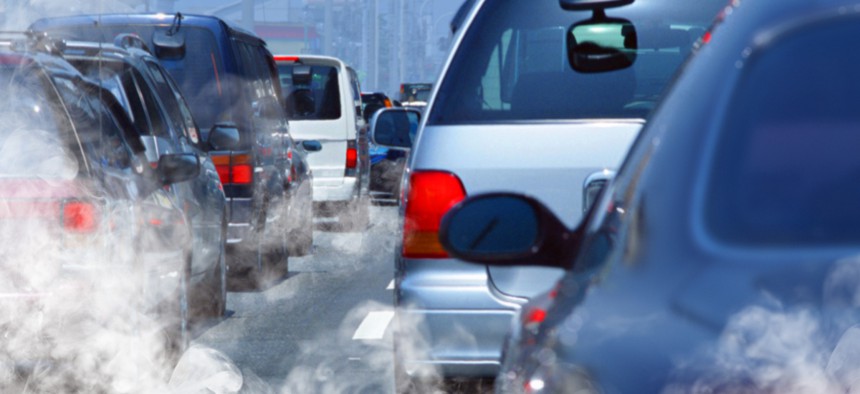Pollution in the Northeast Disproportionately Affects Communities of Color

Vehicles emissions disproportionately impact communities of color. ssuaphotos/Shutterstock
A new study investigates the impact of air pollution from cars, buses, and trucks on African American, Asian American, and Latino populations of the Northeast and Mid-Atlantic.
On average, communities of color in the Northeast and Mid-Atlantic breath 66% more vehicular air pollution than white residents do. The average concentrations for Latino residents and Asian residents are even higher, at 75% and 73% more pollution, respectively.
The Union of Concerned Scientists recently released a report detailing their findings on vehicle pollution, emphasizing that people of different races are not experiencing the issue equally. “We can’t talk about the impacts of air pollution without pointing out who bears the biggest burden,” said Maria Cecilia Pinto de Moura, a report coauthor. “This is a pervasive form of discrimination—and as we work on improving transportation, we need to make sure we’re paying attention to the communities who are hardest hit.”
The report also found that of the 72 million people living in the two regions studied, almost one-fifth live in high-concentration areas where particulate matter pollution levels are over 50% of the state average. Of those living in high concentration areas, 60% were people of color. White residents, by contrast, make up 85% of the population in areas where particulate matter pollution is lowest.
Particulate matter in the air is particularly dangerous, according to Mike Ewall, the executive director of the Energy Justice Network, which is based in Philadelphia. It is produced by the burning of fossil fuels, and can contribute to lung and heart disease, asthma, diabetes, and learning disorders among those who inhale it on a regular basis. “Communities that already suffer from health disparities face even greater challenges from particulate matter coming from refineries and transportation,” he said. “There are communities of color where every child on a block has asthma.”
Those health problems often snowball into much larger issues, as they can result in lost days of work, missed school, and expensive emergency room visits. “People of color in the Northeastern states are more likely to suffer the consequences of bad air,” Pinto de Moura said. “That’s a real danger, and it’s true whether or not these families have a personal vehicle of their own.”
Ewall said that pinning down exactly why communities of color face greater environmental threats is tricky. He phrased it as a “chicken and egg” situation, in which people speculate whether the pollution was there first, and things like redlining or real estate discrimination led communities of color there, or if the communities were there first, and then polluting industries arrived because of resident’s lack of political power.
But regardless of history, highly-localized incidences of diseases caused or exacerbated by pollution have become a source of activism. “People see environmental issues as this thing off in the distance sometimes,” Ewall said. “But with community organizing, we focus on local issues, like asthma and cancer, car traffic and odors. People recognize those issues, because everyone knows someone who has one or both of those conditions. That makes it more immediate.”
Washington, D.C. is a prime example of a city where black residents in particular are subject to higher levels of particulate pollution, but have been fighting back in recent years. In 2012, a black neighborhood called Ivy City went so far as to sue the city over a proposal to establish a bus depot there, with residents saying they were tired of being a “dumping ground” for environmentally-harmful city projects. The neighborhood already served as a parking lot for many government vehicles that run on diesel, including snowplows, salt trucks, and buses; diesel exhaust is a major contributor to particulate matter pollution, according to the study. Three years later, the city changed its plans.
The report urged states to direct their investments to the communities like Ivy City that have been most impacted by pollution. The authors suggested expanding electric vehicle rebate programs for low-income residents, investing in electric vehicle charging structures in communities that suffer from high pollution, and transitioning to cleaner public transportation systems. The report noted that while “the electricity used to charge the vehicle can produce some emissions...in the Northeast and Mid-Atlantic, the Regional Greenhouse Gas Initiative (RGGI), along with investments in solar, wind, and other renewable electricity resources, has greatly reduced emissions from electricity generation.”
A primary concern of local governments for these changes will likely be cost, said Ken Kimmell, president of UCS. “While this transition will require significant investment, there will be a tremendous benefit in the form of improved public health, especially for our most vulnerable residents,” he said.
But while the report suggested increased use of electric vehicles, Ewall said that states need to go even further with their long-term visions. Lead is still used in aviation fuel, which Ewall said is a massive contribution to pollution. “We need to transition to a clean energy sector, with high speed rail trains to get people off of planes, but then parallel to that, we need to get people out of cars,” he said. That goal can be met by expanding bus and train systems so that people don’t have to rely on personal vehicles, but it also provides a chance for new urban planning initiatives. “We generally need to allow more people to live in urban areas with accessible transit,” he said. “In the future, instead of spreading into the suburbs, we need to build more wisely.”
Emma Coleman is the assistant editor for Route Fifty.
NEXT STORY: When a Kid's Lemonade Stand is Illegal






